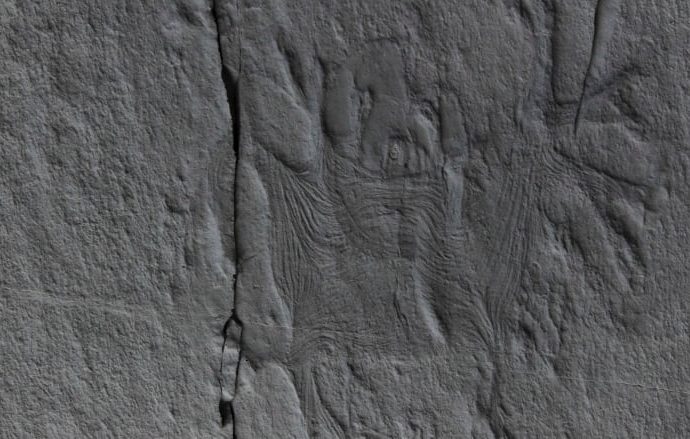It might just look like the imprint of a bat squashed into a rock, kind of like the imprint an unfortunate bird leaves when it collides with a window. But paleontologist Duncan McIlroy says this unassuming item is an amazing find.
Source: CBC News
The Haootia quadriformis fossil, found in the Bonavista area a few years ago, may be the earliest evidence of animal muscle on earth, said McIlroy, from MUN’s department of earth sciences.
“In my opinion, this is one of the most important fossils in the world and it’s certainly the most beautiful thing that I’ve ever worked with,” he told The St. John’s Morning Show.
“Haootia” derives from a Beothuk word that means “demon,” McIlroy said, but the animal itself was a jellyfish relative with four tentacles and was only about 10 centimetres tall. But despite its small stature and all-plankton diet, the Haootia fossil is important enough that it will be featured in the First Animal episode of The Nature of Things on Friday night.
When life exploded
A significant part of the Nature of Things documentary is based on the Burgess Shale, one of the world’s most important fossil sites.
“This is shortly after, actually, the start of the Cambrian explosion, when there was a lot more sort of freedom in the world in that there weren’t a lot of animals, so a lot of different body forms could actually be experimented with,” McIlroy said.

There are several hypotheses about why the Cambrian explosion happened, he said. Some scientists believe it was part of the evolution of predation, when animals began to eat other animals and evolved in an attempt to try to protect themselves. Others think it could be related to the appearance of the first burrowing animals who dug below the earth’s sediment for food or protection, increasing productivity on the bottom of the sea floor.
“They eat microbes, they poop, the microbes eat the poop, the animals eat the microbes, so it started escalating the amount of food that was available,” McIlroy said. More available food, and different kids of food, may have helped animals become increasingly complex — for example, giving them the minerals needed to grow teeth or shells.
But Haootia is from 40 to 50 million years before the Cambrian explosion.
“Haootia is basically part of what we would call the long fuse to the Cambrian explosion,” he said.
“There are animals there, we just don’t see very many of them, but then they explode in terms of diversity and in terms of abundance during the fossil record during the Cambrian.”
Haootia‘s significance
But even if Haootia predates the Cambrian explosion, don’t assume it’s not important.
The fossil’s appearance doesn’t make it entirely clear just what a Haootia quadriformis was. “When we first found it, before we described it, we used to call it the squished bat,” McIlroy said. “It looks like a bat that’s been spread-eagled on the rock.”
You need something that people accept as being definitely an animal, and this is what most people have been accepting.
– Duncan McIlroy
The fossil was found in 2013 and described in 2015. The researchers sat on the find for a bit to figure out what it was, McIlroy said, but in 2015 found another fragment in the Bonavista area that gave them some confidence there were more of these animals nearby.
Essentially, he said, the animal had a disk on a stalk and a cup, with four tentacles. It would have sat a few centimetres above the sea floor, using its tentacles to grab at bits of plankton and pop them in its mouth.
Despite the Haootia‘s primitive form, its fossil has been used to calibrate molecular clocks for dating when things evolve and has yet to be refuted, which McIlroy said is notable in the critical scientific world.
“You need something that people accept as being definitely an animal, and this is what most people have been accepting,” he said. “It’s a big deal.”
In addition to learning more about Haootia quadriformis and the many animals that came after it by watching The Nature of Things on television or on CBC Gem, there will an event at The Rooms on Saturday from 3 p.m. to 4 p.m.
In addition to airing the episode, Jean-Bernard Caron of the Royal Ontario Museum will be on hand to talk about its creation and McIlroy will speak about Haootia — and to share a few new discoveries that are as-yet unpublished.
And for those interested in seeing the fossil, it’s on permanent display in the third level of the Rooms.
Source: CBC News

































Leave a Comment
You must be logged in to post a comment.